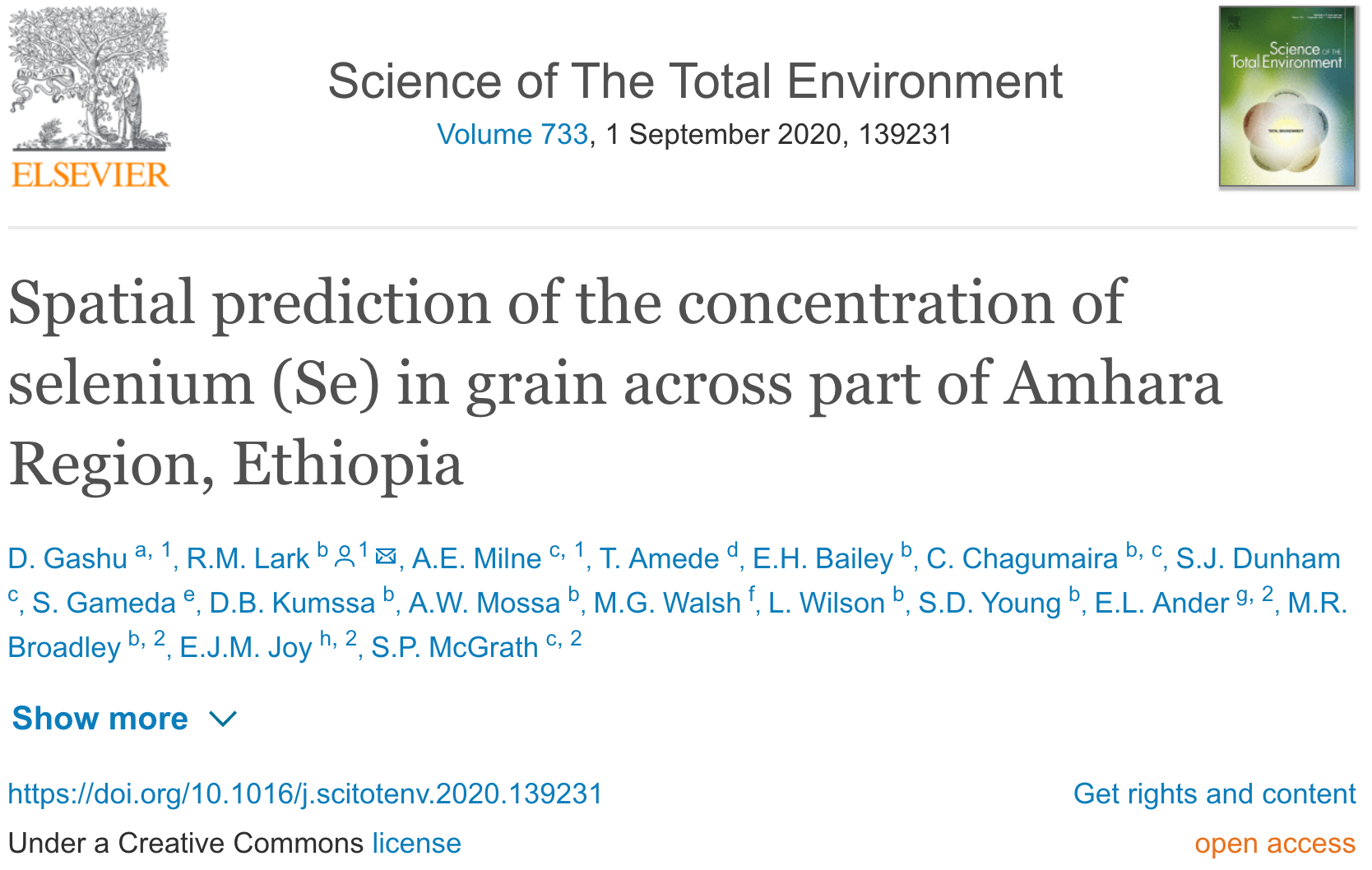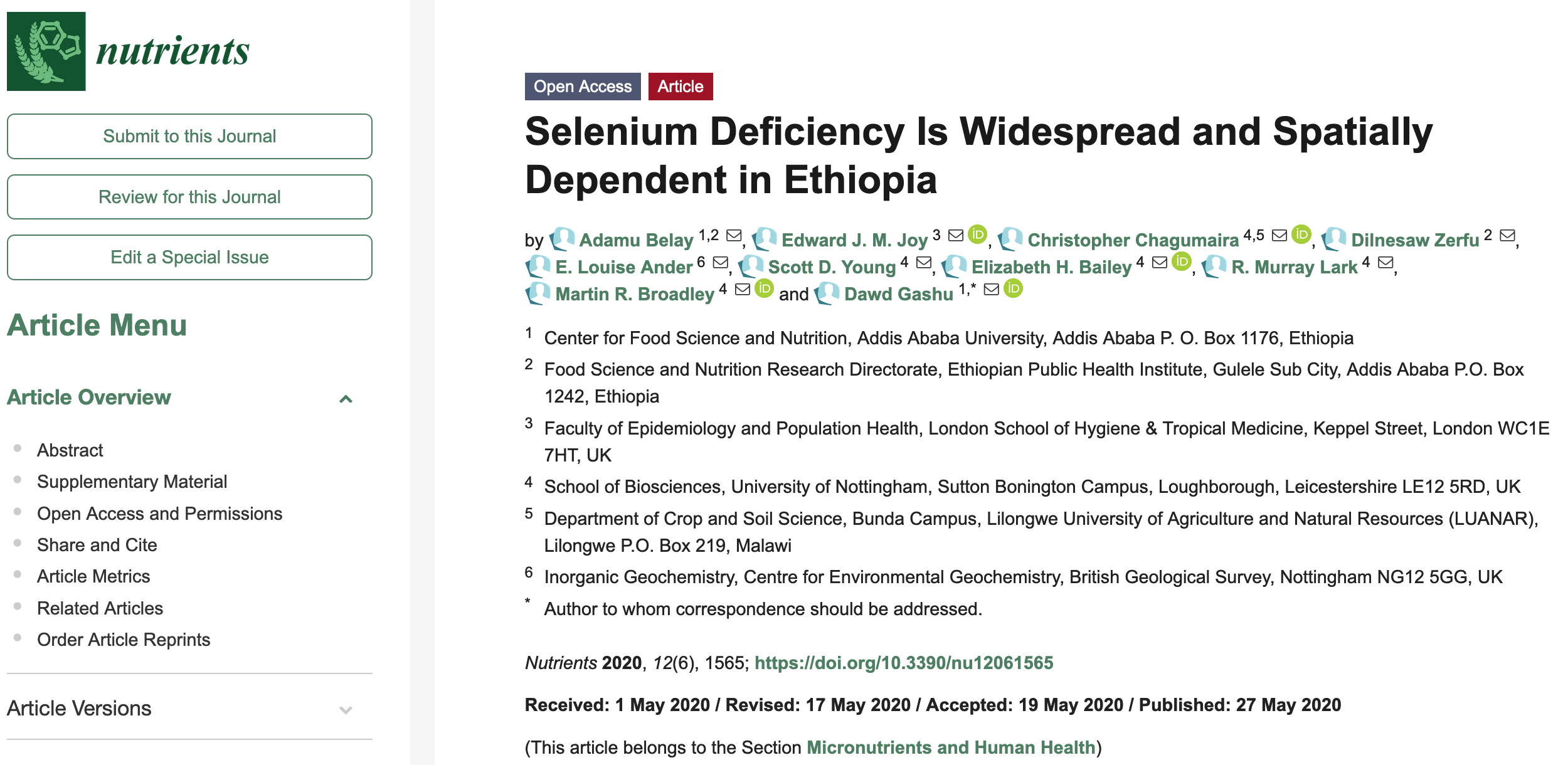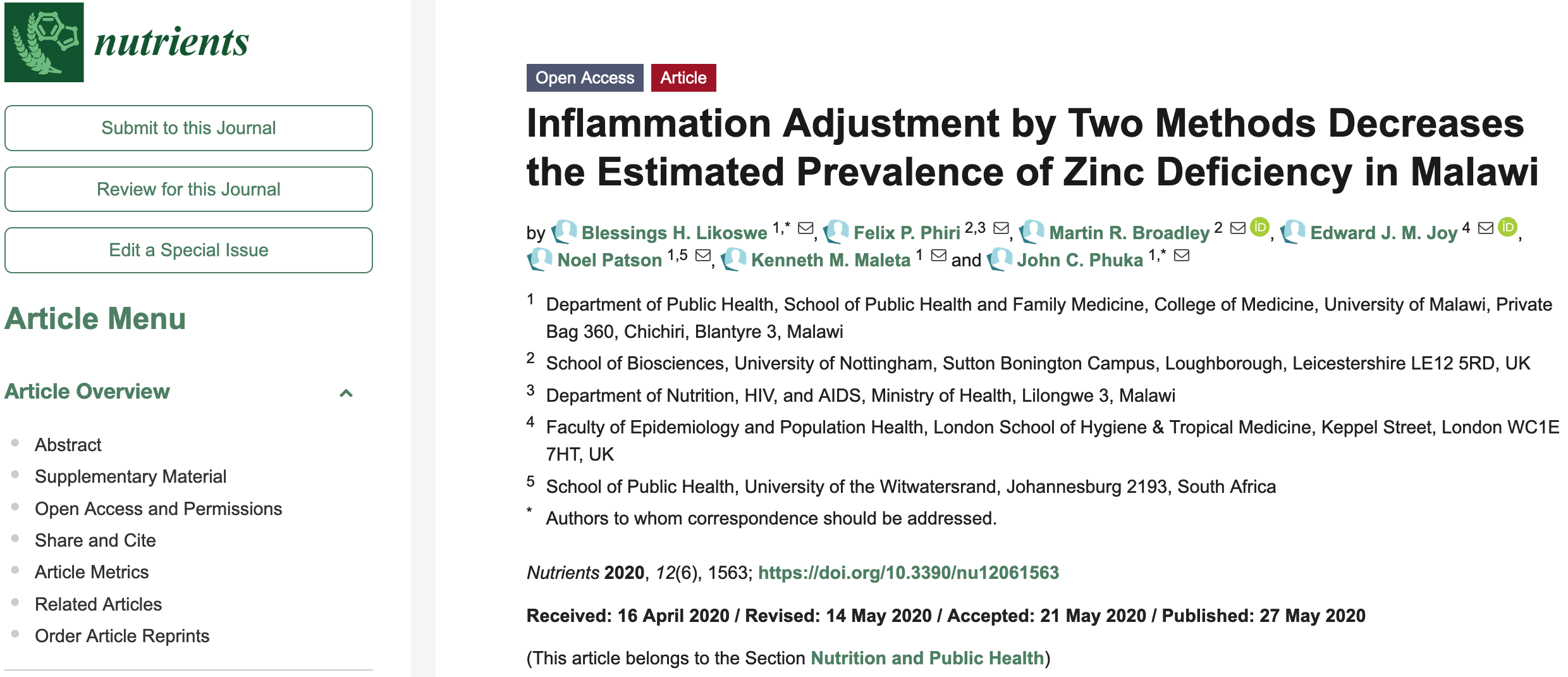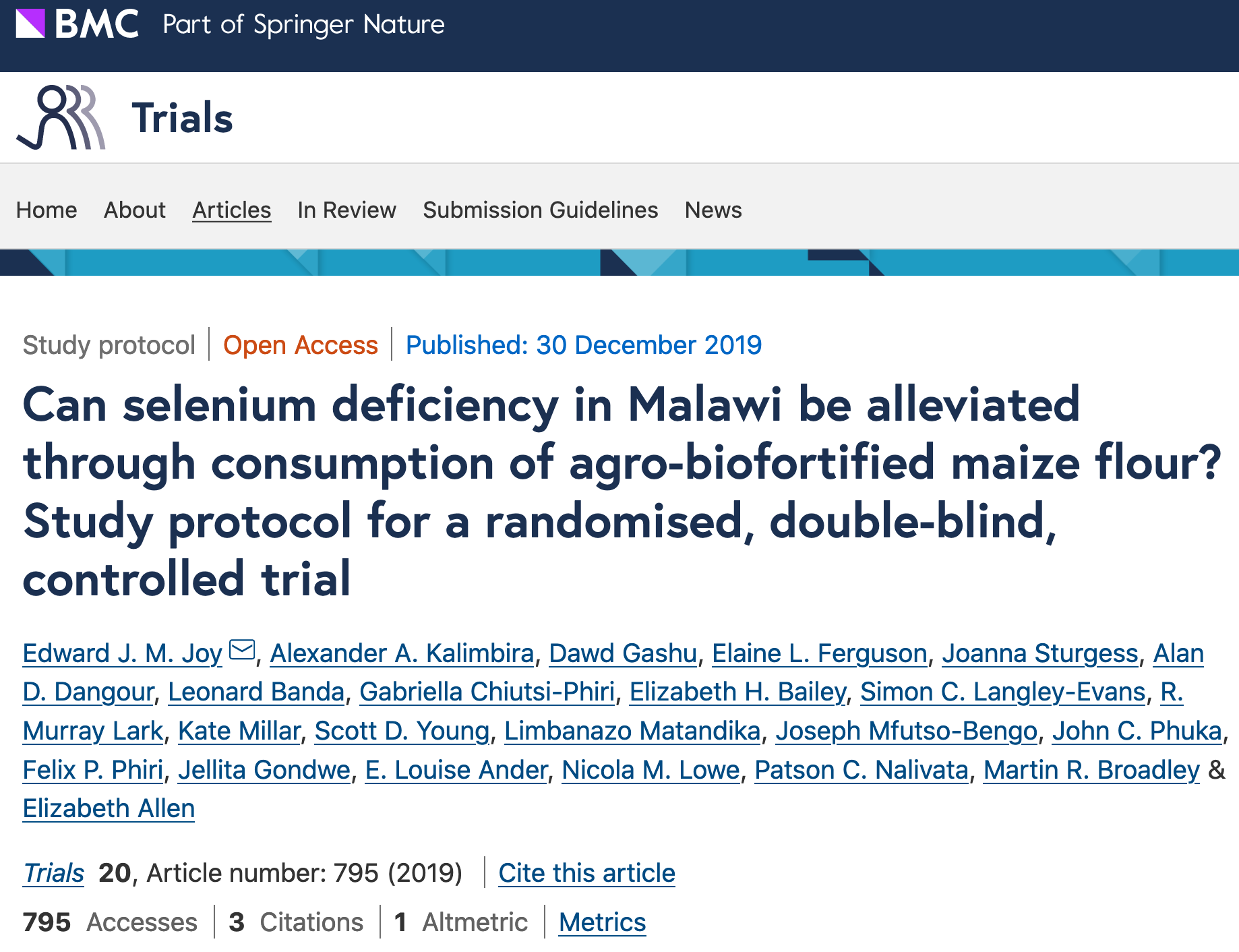Publications
Botoman L, Munthali MW, Chimungu JG, Mossa AW, Young SD, Bailey EH, Ander EL, Lark RM, Nalivata PC, Broadley MR (2020). Increasing zinc concentration in maize grown under contrasting soil types in Malawi through agronomic biofortification: Trial protocol for a field experiment to detect small effect sizes. Plant Direct, in press.
Abstract
Grain and soil were sampled across a large part of Amhara, Ethiopia in a study motivated by prior evidence of selenium (Se) deficiency in the Region's population. The grain samples (teff, Eragrostis tef, and wheat, Triticum aestivum) were analysed for concentration of Se and the soils were analysed for various properties, including Se concentration measured in different extractants. Predictive models for concentration of Se in the respective grains were developed, and the predicted values, along with observed concentrations in the two grains were represented by a multivariate linear mixed model in which selected covariates, derived from remote sensor observations and a digital elevation model, were included as fixed effects. In all modelling steps the selection of predictors was done using false discovery rate control, to avoid over-fitting, and using an α-investment procedure to maximize the statistical power to detect significant relationships by ordering the tests in a sequence based on scientific understanding of the underlying processes likely to control Se concentration in grain. Cross-validation indicated that uncertainties in the empirical best linear unbiased predictions of the Se concentration in both grains were well-characterized by the prediction error variances obtained from the model. The predictions were displayed as maps, and their uncertainty was characterized by computing the probability that the true concentration of Se in grain would be such that a standard serving would not provide the recommended daily allowance of Se. The spatial variation of grain Se was substantial, concentrations in wheat and teff differed but showed the same broad spatial pattern. Such information could be used to target effective interventions to address Se deficiency, and the general procedure used for mapping could be applied to other micronutrients and crops in similar settings.
Abstract
Selenium (Se) is an essential element for human health and livestock productivity. Globally, human Se status is highly variable, mainly due to the influence of soil types on the Se content of crops, suggesting the need to identify areas of deficiency to design targeted interventions. In sub-Saharan Africa, including Ethiopia, data on population Se status are largely unavailable, although previous studies indicated the potential for widespread Se deficiency. Serum Se concentration of a nationally representative sample of the Ethiopian population was determined, and these observed values were combined with a spatial statistical model to predict and map the Se status of populations across the country. The study used archived serum samples (n = 3269) from the 2015 Ethiopian National Micronutrient Survey (ENMS). The ENMS was a cross-sectional survey of young and school-age children, women and men. Serum Se concentration was measured using inductively coupled plasma mass spectrometry (ICPMS). The national median (Q1, Q3) serum Se concentration was 87.7 (56.7, 123.0) μg L−1. Serum Se concentration differed between regions, ranging from a median (Q1, Q3) of 54.6 (43.1, 66.3) µg L−1 in the Benishangul-Gumuz Region to 122.0 (105, 141) µg L−1 in the Southern Nations, Nationalities, and Peoples’ Region and the Afar Region. Overall, 35.5% of the population were Se deficient, defined as serum Se < 70 µg L−1. A geostatistical analysis showed that there was marked spatial dependence in Se status, with serum concentrations greatest among those living in North-East and Eastern Ethiopia and along the Rift Valley, while serum Se concentrations were lower among those living in North-West and Western Ethiopia. Selenium deficiency in Ethiopia is widespread, but the risk of Se deficiency is highly spatially dependent. Policies to enhance Se nutrition should target populations in North-West and Western Ethiopia.
Abstract
Serum zinc concentration (SZC) is used widely to assess population-level
zinc status. Its concentration decreases during inflammatory responses,
which can affect the interpretation of the results. This study aimed to
re-estimate the prevalence of zinc deficiency in Malawi based on the
2015–2016 Malawi Micronutrient Survey (MNS) data, by adjusting SZC
measures with markers of inflammation. SZC and inflammation data from
2760 participants were analysed. Adjustments were made using: (1) The
Internal Correction Factor (ICF) method which used geometric means, and
(2) The Biomarkers Reflecting Inflammation and Nutritional Determinants
of Anemia (BRINDA) method, which used linear regression. Mean SZC values
increased significantly when adjustments were made by either ICF or
BRINDA (p < 0.001). The national
prevalence of zinc deficiency decreased from 62% to 59%, after ICF
adjustment, and to 52% after BRINDA adjustment. ICF and BRINDA values of
SZC were highly correlated (p <
0.001, r = 0.99), but a Bland–Altman plot showed a lack of agreement
between the two methods (bias of 2.07 µg/dL). There was no association
between the adjusted SZC and stunting, which is a proxy indicator for
zinc deficiency. Inflammation adjustment of SZC, using ICF or BRINDA,
produces lower estimates of zinc deficiency prevalence, but the lack of
agreement between the adjustment methods warrants further research.
Furthermore, the lack of association between SZC and stunting highlights
the need to explore other biomarkers and proxies of population zinc
assessment. This study demonstrates the importance of considering
inflammatory confounders when reporting SZC, to ensure accuracy and to
support policy decision making.
Abstract
Selenium (Se) is an essential element for human health. However, our knowledge of the prevalence of Se deficiency is less than for other micronutrients of public health concern such as iodine, iron and zinc, especially in sub-Saharan Africa (SSA). Studies of food systems in SSA, in particular in Malawi, have revealed that human Se deficiency risks are widespread and influenced strongly by geography. Direct evidence of Se deficiency risks includes nationally representative data of Se concentrations in blood plasma and urine as population biomarkers of Se status. Long-range geospatial variation in Se deficiency risks has been linked to soil characteristics and their effects on the Se concentration of food crops. Selenium deficiency risks are also linked to socio-economic status including access to animal source foods. This review highlights the need for geospatially-resolved data on the movement of Se and other micronutrients in food systems which span agriculture–nutrition–health disciplinary domains (defined as a GeoNutrition approach). Given that similar drivers of deficiency risks for Se, and other micronutrients, are likely to occur in other countries in SSA and elsewhere, micronutrient surveillance programmes should be designed accordingly.
Abstract
Background
Micronutrient deficiencies including selenium (Se) are widespread in Malawi and potentially underlie a substantial disease burden, particularly among poorer and marginalised populations. Concentrations of Se in staple cereal crops can be increased through application of Se fertilisers – a process known as agronomic biofortification (agro-biofortification) – and this may contribute to alleviating deficiencies. The Addressing Hidden Hunger with Agronomy (AHHA) trial aims to establish the efficacy of this approach for improving Se status in rural Malawi.
Methods
A double-blind, randomised, controlled trial will be conducted in a rural community in Kasungu District, Central Region, Malawi. The hypothesis is that consumption of maize flour agro-biofortified with Se will increase serum Se concentration. We will recruit 180 women of reproductive age (WRA) (20–45 years) and 180 school-age children (SAC) (5–10 years) randomly assigned in a 1:1 ratio to receive either maize flour enriched through agro-biofortification with Se or a control flour not enriched with Se. Households will receive flour (330 g per capita per day) for 12 weeks. The primary outcome is Se concentration in serum (μg/L). Serum will be extracted from venous blood samples drawn at baseline (prior to flour distribution) and end-line. Selenium concentration will be measured by using inductively coupled plasma mass spectrometry.
Discussion
Findings will be communicated to policy stakeholders and participating communities and reported in peer-reviewed journals.




